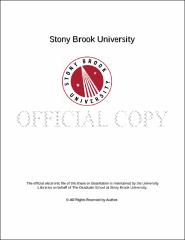| dc.identifier.uri | http://hdl.handle.net/11401/77074 | |
| dc.description.sponsorship | This work is sponsored by the Stony Brook University Graduate School in compliance with the requirements for completion of degree. | en_US |
| dc.format | Monograph | |
| dc.format.medium | Electronic Resource | en_US |
| dc.language.iso | en_US | |
| dc.publisher | The Graduate School, Stony Brook University: Stony Brook, NY. | |
| dc.type | Dissertation | |
| dcterms.abstract | High energy density rechargeable batteries have been widely investigated and optimized for portable electronics applications. However, research into novel electrode materials with higher energy densities and better ionic transport is needed to develop next-generation rechargeable batteries that can satisfy the requirements of the emerging technologies of electric vehicles and grid-scale energy storage. These needs motivate the present investigation of a new class of nitridophosphate ceramics for use as cathodes or solid state electrolytes in rechargeable batteries. Nitridophosphate compounds with general formula of A2M2P3O9N and A3MP3O9N (A = monopositive cation, M = divalent or trivalent cation) are demonstrated to be the first N3--containing cathode materials for rechargeable batteries, exhibiting a variety of advantages over conventional O2--based cathodes. Na3TiP3O9N and Na3VP3O9N have the highest Ti4+/Ti3+ and V4+/V3+ redox potentials ever reported for Na-ion batteries, and have remarkably small volume changes during cycling. The Li-ion analogues of these compounds cannot be directly synthesized, but can be prepared through new non-molten solid ion exchange methods developed in the course of this work. In addition to having higher capacities, the Li-ion analogues (Li2Fe2P3O9N, Li2TiP3O9N, and Li3VP3O9N) have higher ionic conductivities and better rate performance. Additionally, metastable nitridophosphate systems with redox-inactive M cations (Li2Mg2P3O9N, Li3AlP3O9N and Li3GaP3O9N) are demonstrated to have high ionic conductivities which are promising for applications as solid state electrolytes. The isotropic three-dimensional ion transport pathways in these cubic compounds have been mapped out and quantified using a combination of structural, electrochemical and theoretical methods. New structure characterization tools have been developed in support of these materials design efforts. The first-ever in situ neutron diffraction study of Li+/Na+ ion exchange was successfully carried out, allowing the detailed mechanism of the ion exchange reaction to produce Li2Mg2P3O9N to be resolved. Additionally, quantitative studies of stacking faults in technologically important honeycomb-ordered transition metal oxide cathodes were carried out, allowing kinetic and thermodynamic aspects of the order-disorder transition to be distinguished. These results highlight the importance of structure knowledge when designing materials for rechargeable batteries. | |
| dcterms.available | 2017-09-20T16:51:51Z | |
| dcterms.contributor | Khalifah, Peter G | en_US |
| dcterms.contributor | Parise, John | en_US |
| dcterms.contributor | Aubrecht, Katherine | en_US |
| dcterms.contributor | Yang, Xiao-Qing | en_US |
| dcterms.contributor | Gan, Hong. | en_US |
| dcterms.creator | LIU, JUE | |
| dcterms.dateAccepted | 2017-09-20T16:51:51Z | |
| dcterms.dateSubmitted | 2017-09-20T16:51:51Z | |
| dcterms.description | Department of Chemistry. | en_US |
| dcterms.extent | 269 pg. | en_US |
| dcterms.format | Monograph | |
| dcterms.format | Application/PDF | en_US |
| dcterms.identifier | http://hdl.handle.net/11401/77074 | |
| dcterms.issued | 2015-05-01 | |
| dcterms.language | en_US | |
| dcterms.provenance | Made available in DSpace on 2017-09-20T16:51:51Z (GMT). No. of bitstreams: 1
LIU_grad.sunysb_0771E_12630.pdf: 21522335 bytes, checksum: 6e4d73e5ee8b2f8e200c8c901692f10f (MD5)
Previous issue date: 2015 | en |
| dcterms.publisher | The Graduate School, Stony Brook University: Stony Brook, NY. | |
| dcterms.subject | Chemistry | |
| dcterms.subject | CUBICON, In situ diffraction, Nitridophosphates, Pair distribution function, Rechargeable batteries, Stacking faults | |
| dcterms.title | Nitrogen-containing CUBICON ceramics and their applications for rechargeable batteries | |
| dcterms.type | Dissertation | |

